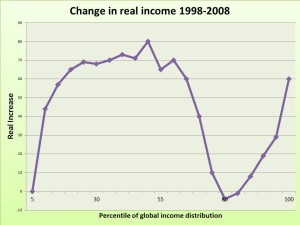Another window on high-value philanthropy just opened in Italy thanks to UNHCR and Gruppo Kairos, a private banking and wealth management firm. In March, UNHCR published the results of a survey carried out with the finance firm. I am grateful to Giovanna Li Perni at UNHCR for a copy of the report, and for her presentation of the results at last week’s Festival del Fundraising.
During October-November 2015 Kairos asked its HNWI clients to complete a questionnaire; 91 of them, 44% women, 56% men, did so. This is not therefore a balanced representative sample of people of wealth in Italy (so we cannot safely extrapolate the results) but does give us at least some insight into how this group of people reacted. The group included a wide range of wealth levels from €1m to more than €30m, and a spread of age groups with, as you would expect, a bias toward middle age and older (85% were aged 46 or over). Almost all of the group were donors – 91% had made at least one donation to a social cause in the previous year (against 26% of the general population). The percentage who gave rose with increasing wealth, reaching 100% of people with wealth over €30m.
When asked about their largest gift during 2015 to any one organisation, most reported €5,000, with 73% of women giving at this level and 49% of men. Older people tended to give more, so 22% of the over-65s gave €25,000 and 11% gave €50,000. Of course these people were giving to a number of organisations, so 30% of this older group gave away a total of between €50,000-€100,000 in 2015.
Asked about the causes to which they made their largest gift in 2015, 21% chose scientific or medical research, 19% favoured children’s causes, and 16% poverty in Italy. Importantly for UNHCR, 10% chose help and protection for refugees as their top cause. 62% gave principally to causes in Italy.
Why did they give?
More than half (52%) said that their main reason for giving was because they felt privileged. 26% said it was giving made them feel useful. Interestingly just 4% of donors said that they gave because of their religious values, with 9% saying that they want to change things, to make a difference and the same percentage saying that they gave to continue a family tradition of philanthropy.
In choosing a non-profit, two major reasons stood out; the cause, and ‘transparency of the organisation and exhaustive documentation on results.’ This focus on transparency is interesting and is part of a trend we can see across Europe toward greater transparency in the non-profit sector. New laws (for example, in Holland) and new organisations (for example Fundación Lealtad in Spain) are encouraging this trend toward transparency.
Italians will tell you that business in the country is based on personal connections, and it seems that this might be true for philanthropy also. It is certainly the case for this group of philanthropists, who say that the most common channel for hearing about the organisations they support is via their personal network (28% of respondents, the largest single group), while 15% say that they chose the cause because they knew the leader of the organisation in person.
What does this tell us about strategy?
The information in this report is gathered from the clients of one bank, so we should be careful about extrapolating from it. But given that there is almost nothing else available on HNWI philanthropy in the Italian market, we might at least test some conclusions.
The research should help push up the pricing of ‘major donor’ programmes. Individuals responding to this survey have made gifts in excess of €100,000 to single organisations, and 20% of them have made gifts of €25,000 or more. We can even venture a Gift Capacity calculation for this group, defining ‘Gift Capacity’ as ‘The largest total gift that one person could give to any one cause, in ideal conditions, over five years’ (see my previous blog on this topic.) Five of the respondents with net worth of €5-€10m made gifts to single organisations of €100,000 or more, between 1% and 2% of their net worth.
The research makes the case for prospect research. It shows that personal networks are the means by which these HNWIs have been reached by their non-profit partners, and that these networks are their primary source of information. Prospect research has the tools to identify personal networks. Sadly, the number of prospect researchers in Italy is still in single figures.
This research was carried out in partnership with Gruppo Kairos, and we have here a strategic clue that a number of NGOs in Europe are starting to follow up. Private wealth managers and bankers are increasingly interested in philanthropy, and we would all do well to focus more attention on this key group of intermediaries.
This is the second year in which UNHCR and Kairos have carried out this study, and the plan is to continue the annual series; another opening window on the world of HNWI philanthropy in Europe.

